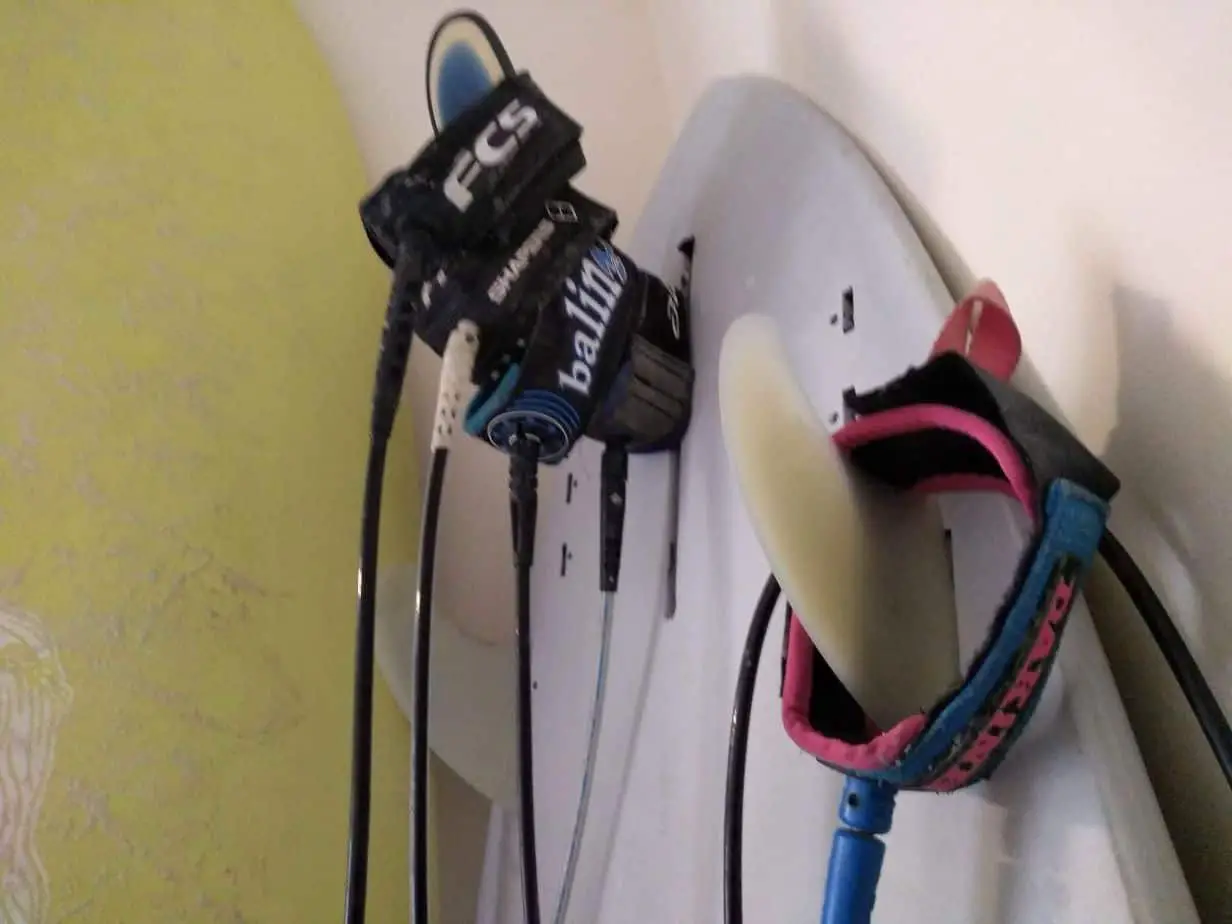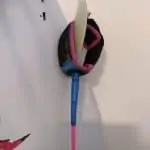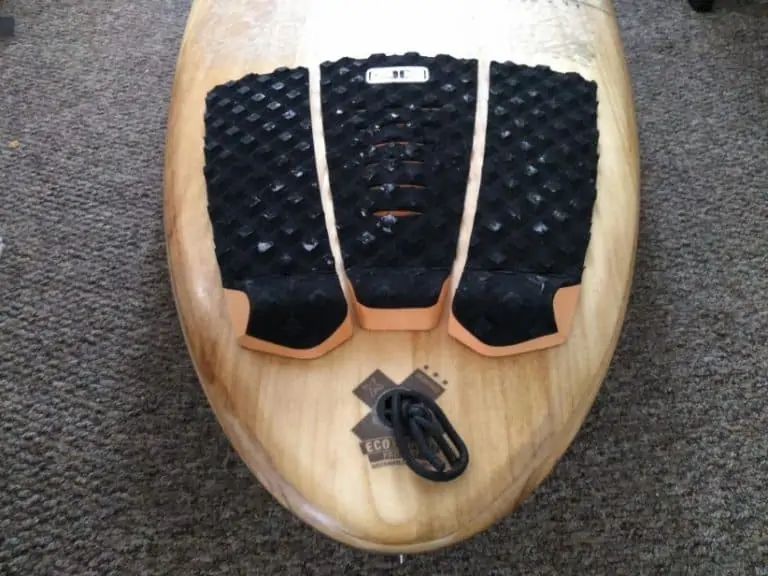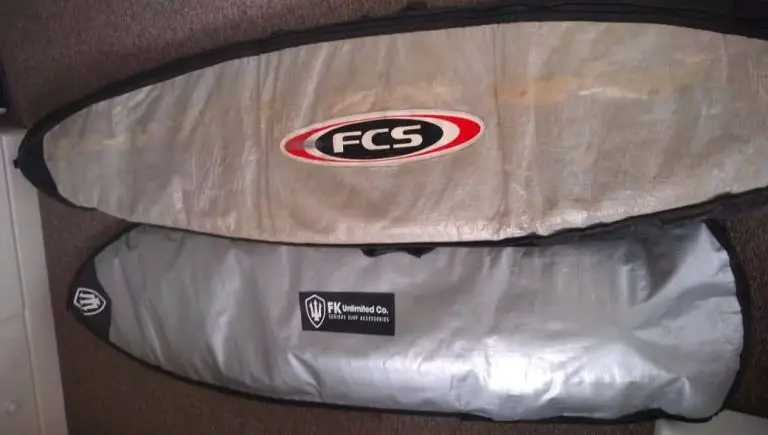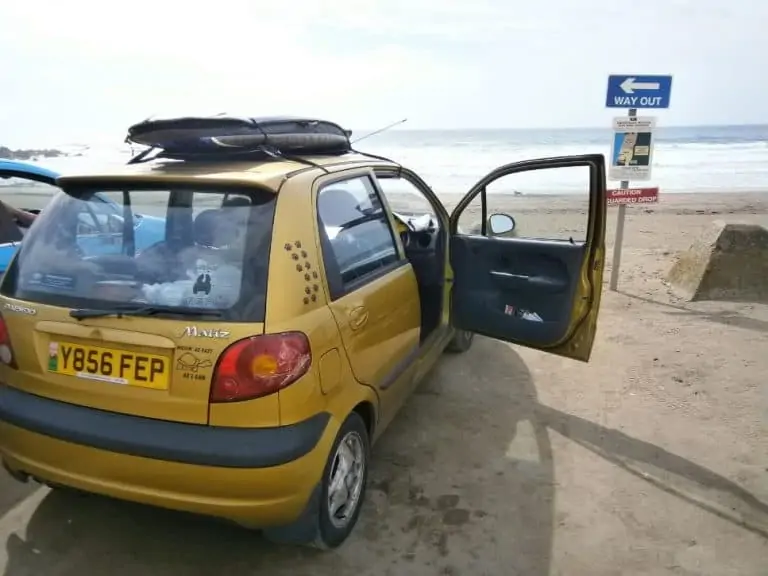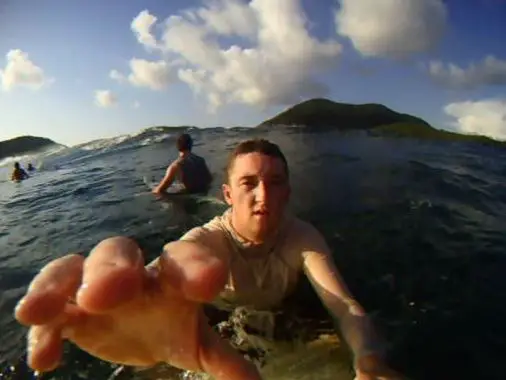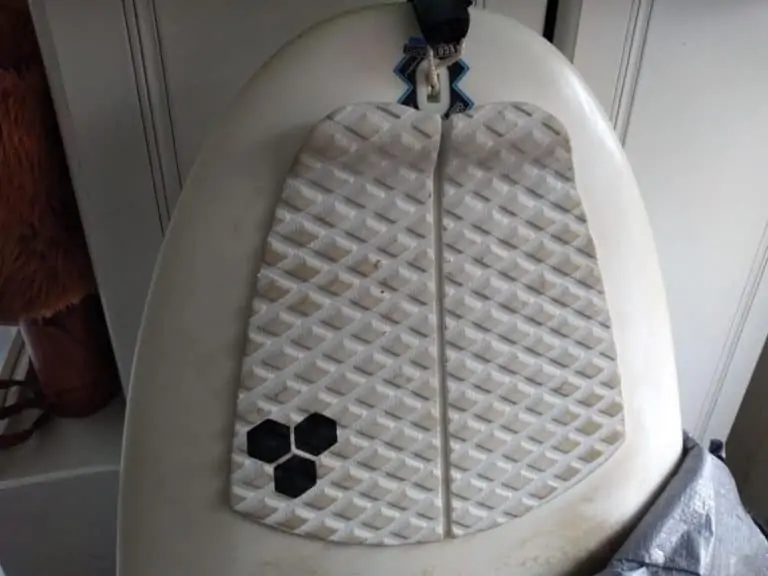The ULTIMATE Surfboard Leash Guide!
When you start out surfing, choosing a good surfboard leash is an essential part of your surfing equipment and accessories.
Obviously, the surfboard leash keeps you attached to your board. So when you fall off, you don’t have to swim in every time, as surfers used to have to do in the olden days.
Now, leashes are affordable and designed well to help us surfers get more waves and have more fun doing it.
So to get started, you might be wondering:
What is the best surfboard leash? Any leash from a reputable surf hardware brand that is the same length as your board, or a little longer. For boards in between lengths, say 8’6″, go longer and get a nine-foot leash.
Don’t get a competition (or ‘comp’) leash because they’re thin and break easily. This is also the reason why they’re cheaper than standard leashes, so you pay less for an inferior product, in effect.
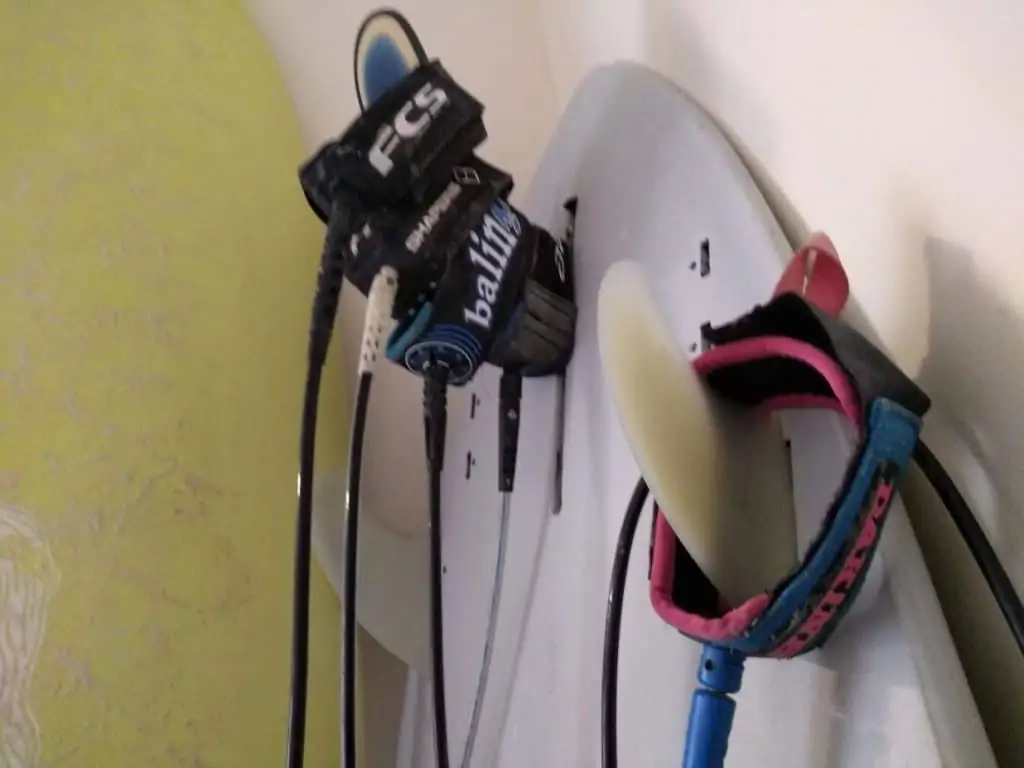
As such, my top recommendations for surfboard leashes from Amazon are as follows:
- FCS standard surfboard leash
- Dakine leashes
- Ho Stevie! leashes (for more of an indepent but still reliable hardward vibe)
Remember that should also buy a brand new leash because second-hand ones will have worn down over time and the Velcro becomes much less sticky. So don’t buy them. It is a false economy and using an old leash can be downright dangerous if it breaks when you are out in the surf.
Now with that out of the way, let’s move on and look at some of the parts of the leash, as well as answering more frequently asked questions about surfboard leashes. So let’s get to it.
How long should a surfboard leash be?
Surfboard leash should be approximately the same length as your surfboard or a little bit longer. They only come in sizes of one whole foot. So if your board is 6’7″, get a seven foot surfboard leash.
This means that it is proportional to the length of your board, so if you fall off, it won’t be so short that it will fly back at you.
It can be dangerous, like a missile coming towards you when you pop up after a wave, which can happen and has happened to me in the past. So always get the right length surfboard leash.
How do you attach a surf board leash to your board?
Your board already has a leash plug in it, and you simply need to loop the cord that comes with your surfboard leash through the plug. Tie it in a way that is fastened and secure, as you can see in the video below.
Also, attach the Velcro quick release part of your surfboard leash. The quick release part is the flat Velcro fabric and with the cord next to the part where the cord is, it is also called a rail saver.
If you imagine the cord polling on the rail of your surfboard on its own, that can cause a lot of pressure and rip through the surfboard. It is what used to be a common cause for dings and surfboards being damaged.
Now, the rail saver is flatter and wider so it stops that pressure. It also helps you to take off your leash with ease. Once you’ve put a cord in your surfboard, you can leave it there, just take your leash and leave the cord.
Be sure that the knot in your leash cord which attaches to the leash plug is solid and will not pull through even with the brute force of a wave.
Take note that what looks like solid on land can also be very different out in the surf. I’ve had these knots come undone too in various situations.
What is a surfboard leash cord made of?
It’s made of a similar material to a parachute string. You can be sure that it will hold your weight and a lot more, as well as withstanding the force of an oncoming wave. To be sure, this is the string that attaches your leash to your surfboard.
If you run out of this, the best way is to buy it cheaply on sites like eBay or Amazon. Just search for parachute cord string or surfboard leash cord and you will find what you need. You will be sure that it is strong enough.
It’s also a lot cheaper than buying it from surf shops who sell it pre-tied. Although, it is nice but you are paying a lot more for the luxury and convenience. So bear that in mind.
Instead, you might just want to get like a parachute cord type string for a couple of metres. It will only cost you a few dollars.

What are the best surfboard leash brands?
The best are the surf hardware brands like Dakine, FCS, Creatures of Leisure, any brands that make good board bags also make good leashes.
For instance, Dakine is based in Hawaii and they make products to withstand Hawaiian waves so you can be sure they are going to give you a durable product.
They also sponsor a lot of professional surfers who use their equipment in big waves. I know. Some sponsorships don’t mean much but with Dakine you can be sure that it’s a good quality product.
Similarly, FCS do very good leashes. I’ve always found them to be very useful. I like their hardware and I’ve bought their products for many years.
So those would be my two top picks, as well as brands like Creatures of Leisure and a few other ones that do good board bags as well.
How much do surfboard leashes costs?
Generally speaking, they start at $20 and they can go up to anything around $50 to $60, depending on the length and style of your leash.
Surfboard leashes are getting more expensive, the longer and more heavy duty it is. If you were to buy a stand-up paddleboard leash, then that might be much more expensive than a leash for a child on a small surfboard.
Generally, $20 is a good starting point for surfboard leashes. Don’t go too cheap on a leash though because it is a safety piece of equipment. So never buy a cheap leash.
You will get some leashes that come with learner surfboards as a starter kit, which is nice. However, as soon as you start going out of your depth into the deeper water, you need a good quality leash.
Again, I have had a leash break on me before when I was surfing. I nearly drowned because I was surfing in a dangerous area. The leash, in that case, was a bit old and the waves were very powerful.
So get yourself a good leash. Don’t get caught out and I should add, I’ve also had to swim in many times in the past for having a leash that doesn’t work. You will be ready to surf in any conditions with peace of mind.
How to take care of a surfboard leash?
The best things I can say are to keep it free of sand, wherever possible. So, do not drag it along the floor. Always carry it in your hand.
When you are out of the surf, do not wrap it around your board tightly. This will cause it to tangle. Instead, hang it on a fin or something or the hook that is soft and keep the leash as straight as you can at all times.
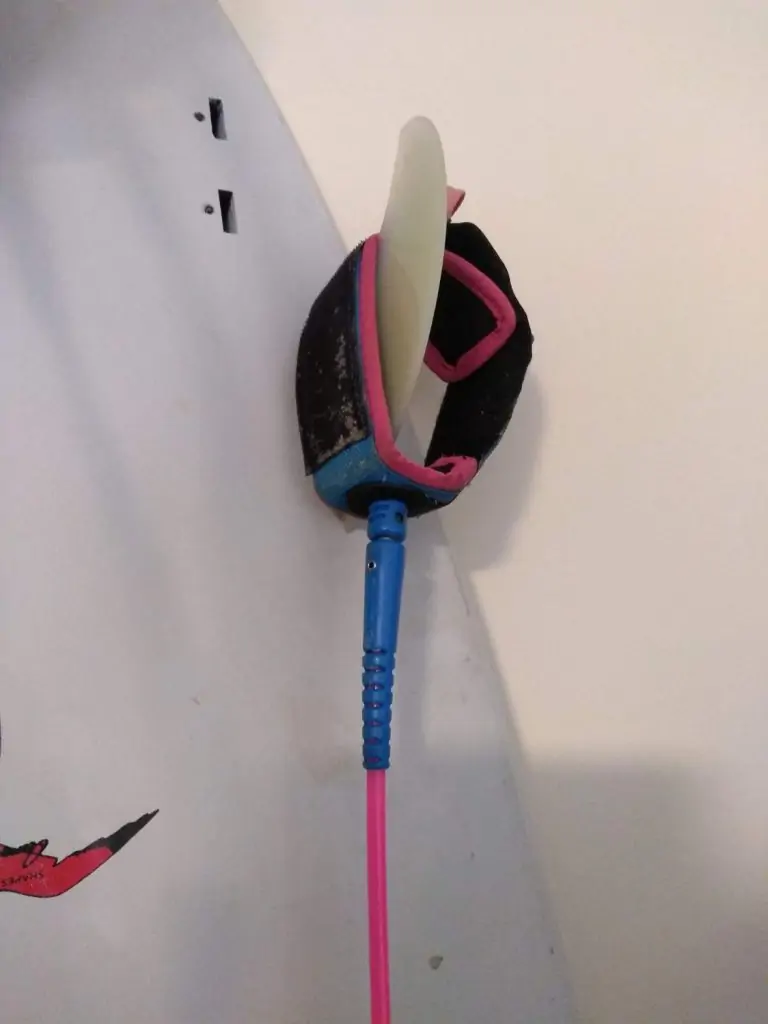
If your surfboard leash starts to tangle, it can wrap around your ankles, tripping you up on the board, making surfing very difficult. So be careful with that.
Another point with leash maintenance is changing it every couple of years. If you’re surfing frequently in powerful waves, let’s say Hawaii or Indonesia, perhaps every six months because they do have limited shelf life.
The more trials and tribulations you put them through, wipe outs, and waves, the shorter that life span will be. So be sure take your leash and change it every six months for heavy users or two years for regular users.
I would not recommend selling it to other people simply because you don’t know how long it’s going to last for them. So, think about that as well.
Can you use a coiled leash with a surf board?
No. These are for body boarding only and if you try to use them, they will trip you up. They are not designed for surfing and you should not use a coiled leash.
Always have a straight surfboard leash and do not wrap it up, to avoid it getting coiled or kinked, and that will have the same effect.
Can you repair surfboard leashes?
Some surfboard leashes come with separate parts and these parts break. In my experience, no you can’t. It’s very difficult to buy the spare parts or you don’t want to simply because it causes a rupture that is impossible to fix.
Also, you need to be mindful that surfboard leashes have Velcro that does wear down over time. So it may not be worth fixing your surfboard leash, as they only have a limited shelf life.
Should you get a surf leash with a key pocket?
You can do this, but they can be uncomfortable on your ankle because your key can be quite large and bulky. And also, you will need a key that is not electronic because it will get wet. Again, this is something I’ve used.
The key pocket is in behind the Velcro, but it can be quite uncomfortable. Instead, I would recommend using an Aqua pack waterproof pouch to carry your key and put that down your back in with your wetsuit.
Probably a more comfortable and easier option than having a surfboard with a key pocket. Oh, sorry. A surfboard leash with a key pocket in it.
Related Question
Can you surf without a leash? You can surf without a leash but be sure that there are no other people around you or that you are of a good level. If surfing with no leash, you will lose your board frequently. You need to be prepared to chase after it and not cause any harm or danger to any others.
Some advanced and professional surfers surf without a leash when the waves are small because it reduces the drag. The leash in the water behind you actually slows you down a little bit, due to this drag.
Pro surfers like to go in without a leash for small waves to give them that extra boost in speed. However, as mentioned, be sure that you are not putting anyone or yourself in danger if you go in without a leash.
I would recommend always having a leash, unless you’re absolutely sure and know exactly what you’re doing.
